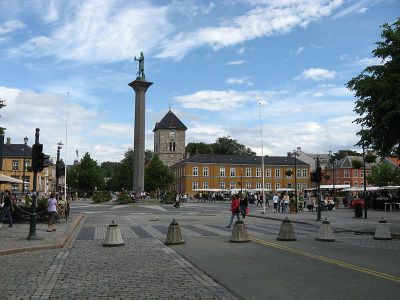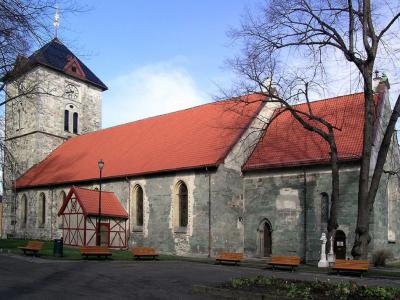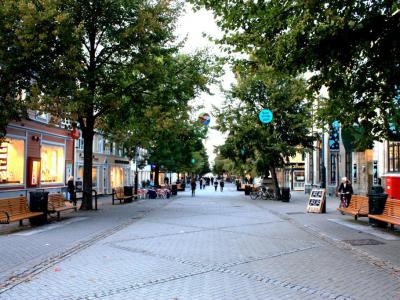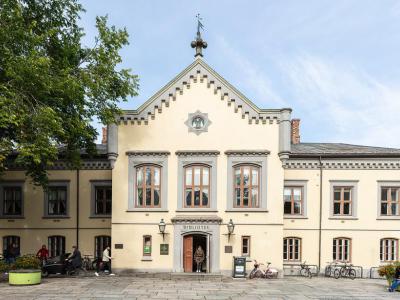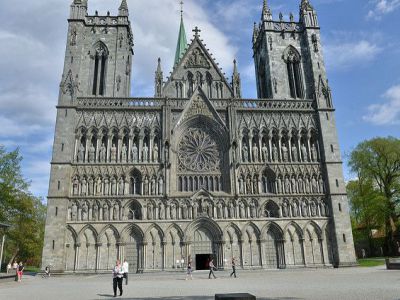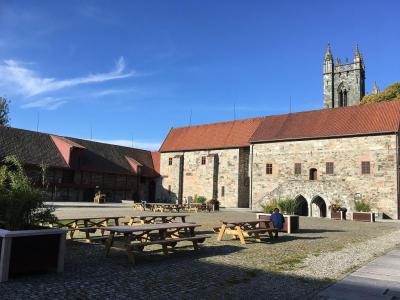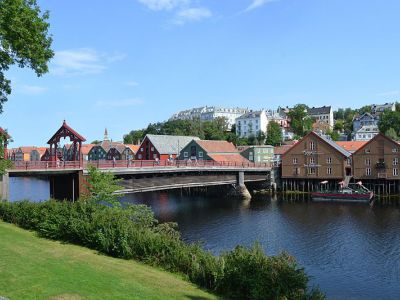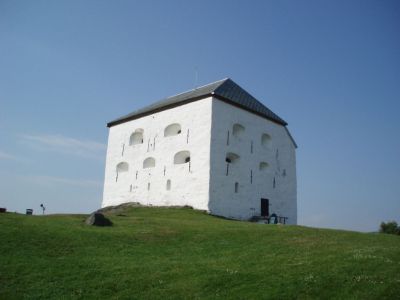Trondheim Introduction Walking Tour (Self Guided), Trondheim
Trondheim was the first capital of Norway. It is the place where kings are consecrated. It is idyllically located on the river Nidelva within easy access to the sea. It has been the home of saints and warriors. It is called Trondheim. "Trond" is a "good place." "Heim" means "home." It is not too big a stretch to say "Trondheim" is a "good home."
Olav Tryggvason, better known as Olav I, founded the good home in 997. He called it Kaupangen, meaning "Trading Place." He only ruled for three years but he had established the capital of Norway. A capital for the age of the Vikings until 1217.
The city has been ravaged by fires in its history. Invasions by Sweden from time to time were a grim accompaniment to the fires. The fire of 1681 led to a total reconstruction of the town as directed by General Johan Caspar von Cicignon, a military engineer originally from Luxembourg.
The old city center is not hard to explore on foot. Start with the old Town Square. Olav I's statue, erected in 1921 by Wilhem Rasmussen, is atop a 58 foot column overseeing the square.
Nidaros cathedral is close by. It is the final resting place of Saint Olav (King Olav II) and the traditional site for royal coronations. The Archbishop's Palace is a treasure trove of archeological history. It also has the crown jewels of Norway.
A brief walk from the cathedral is the district of Bakklandet, a neighborhood of Hanseatic houses and narrow streets. It can be reached by walking over the Old Town Bridge. The bridge leads to Bakklandet and Kristianstet Fortress.
Our Lady's Church (Var Frue Kirke), was erected around 1200. It has been damaged and restored many times. The list of churches goes on. There are museums, including the Maritime museum of the days of sail. And there's shopping, hiking, skiing (in season), Midsummer festival and the annual celebratory wake of King Olav I.
Trondheim started as a good place to trade and became a good home over a thousand years ago. It still is.
Olav Tryggvason, better known as Olav I, founded the good home in 997. He called it Kaupangen, meaning "Trading Place." He only ruled for three years but he had established the capital of Norway. A capital for the age of the Vikings until 1217.
The city has been ravaged by fires in its history. Invasions by Sweden from time to time were a grim accompaniment to the fires. The fire of 1681 led to a total reconstruction of the town as directed by General Johan Caspar von Cicignon, a military engineer originally from Luxembourg.
The old city center is not hard to explore on foot. Start with the old Town Square. Olav I's statue, erected in 1921 by Wilhem Rasmussen, is atop a 58 foot column overseeing the square.
Nidaros cathedral is close by. It is the final resting place of Saint Olav (King Olav II) and the traditional site for royal coronations. The Archbishop's Palace is a treasure trove of archeological history. It also has the crown jewels of Norway.
A brief walk from the cathedral is the district of Bakklandet, a neighborhood of Hanseatic houses and narrow streets. It can be reached by walking over the Old Town Bridge. The bridge leads to Bakklandet and Kristianstet Fortress.
Our Lady's Church (Var Frue Kirke), was erected around 1200. It has been damaged and restored many times. The list of churches goes on. There are museums, including the Maritime museum of the days of sail. And there's shopping, hiking, skiing (in season), Midsummer festival and the annual celebratory wake of King Olav I.
Trondheim started as a good place to trade and became a good home over a thousand years ago. It still is.
How it works: Download the app "GPSmyCity: Walks in 1K+ Cities" from Apple App Store or Google Play Store to your mobile phone or tablet. The app turns your mobile device into a personal tour guide and its built-in GPS navigation functions guide you from one tour stop to next. The app works offline, so no data plan is needed when traveling abroad.
Trondheim Introduction Walking Tour Map
Guide Name: Trondheim Introduction Walking Tour
Guide Location: Norway » Trondheim (See other walking tours in Trondheim)
Guide Type: Self-guided Walking Tour (Sightseeing)
# of Attractions: 9
Tour Duration: 1 Hour(s)
Travel Distance: 2.2 Km or 1.4 Miles
Author: leticia
Sight(s) Featured in This Guide:
Guide Location: Norway » Trondheim (See other walking tours in Trondheim)
Guide Type: Self-guided Walking Tour (Sightseeing)
# of Attractions: 9
Tour Duration: 1 Hour(s)
Travel Distance: 2.2 Km or 1.4 Miles
Author: leticia
Sight(s) Featured in This Guide:
- Torvet (Town Square)
- Var Frue Kirke (Our Lady's Church)
- Nordre Gate Street
- Gamle Radhus (Old Town Hall)
- Nidaros Cathedral
- Archbishop's Palace & Museum
- Gamle Bybro (Old Town Bridge)
- Bakklandet
- Kristiansten Fortress
1) Torvet (Town Square)
Olaf Tryggvason, son of Tryggvi Olafsson, and great grandson of Harald Fairhair, will always be remembered as Olaf I. He is known to have had four wives who brought him good luck. He settled in Ireland but he was lured to Norway to battle Jarl Haakon. He defeated Haakon in the year 996 and became king.
But in 1000 AD Olaf, in turn, was defeated at sea by the Danes, Swedes and Wends. In the battle he was thrown into the sea and was never seen again. His reign by the River Nid in Trondheim was short but busy. He founded Trondheim and its Town Square (Torvet).
Town Square was set up as a place for commerce and events. The city was near destroyed by fire in 1681. Johan Caspar de Cicignon, a renowned general and military engineer, drew up a new layout for the city. The boundaries of the Town Square were set and have remained so to this day. Johan favored the Baroque in anything he built or rebuilt.
In 1921 Wilhelm Rasmussen, a well known sculptor of Norway, unveiled his monument to King Olaf I. The monument is a 58 foot column in the center of the square. King Olaf stands on a pedestal at the top. The statue doubles as a sundial as drawn on the cobblestones below.
Town Square at one time was bound on three sides by elite mansions of the wealthy. Now Olaf presides over a shopping center and tourists taking their ease.
But in 1000 AD Olaf, in turn, was defeated at sea by the Danes, Swedes and Wends. In the battle he was thrown into the sea and was never seen again. His reign by the River Nid in Trondheim was short but busy. He founded Trondheim and its Town Square (Torvet).
Town Square was set up as a place for commerce and events. The city was near destroyed by fire in 1681. Johan Caspar de Cicignon, a renowned general and military engineer, drew up a new layout for the city. The boundaries of the Town Square were set and have remained so to this day. Johan favored the Baroque in anything he built or rebuilt.
In 1921 Wilhelm Rasmussen, a well known sculptor of Norway, unveiled his monument to King Olaf I. The monument is a 58 foot column in the center of the square. King Olaf stands on a pedestal at the top. The statue doubles as a sundial as drawn on the cobblestones below.
Town Square at one time was bound on three sides by elite mansions of the wealthy. Now Olaf presides over a shopping center and tourists taking their ease.
2) Var Frue Kirke (Our Lady's Church)
Our Lady's Church was originally called Saint Mary's Church (Mariakirken). It was constructed in the late 1100s by architect Bjorn Sigvardsson. The plan is of a "Long" church, peculiar to Scandinavia, especially Norway. The nave is one long room with a flat ceiling. The church is of stone, plain, but with Romanesque and Gothic elements.
In 1651 the church and most buildings in Trondheim were destroyed by fire. It was rebuilt and redecorated only to be burned again in 1681 and again in 1708. In rebuilding, the church nave was extended to the west. The resulting length became 210 feet.
Major renovations had taken place by 1779. A new tower with a pyramid roof and spire had been installed and the church had acquired a baroque ambience. In the 19th century, under the direction of architect Christian Christie, most of the Baroque and Rococo elements of the interior were eliminated.
During the period 1957 to 1959 John Egil Tverdahl restored the church to its original medieval stone appearance.
The altarpiece was carved by Heinrich Kuhnemann in 1744. It was originally meant for Nidaros Cathedral. In 1837 it was moved to Our Lady's Church. It was painted by J. N. Schavenius. The pulpit was restored in 1959. The baptismal font dates from 1898.
The church is always welcoming and open for prayer and meditation.
In 1651 the church and most buildings in Trondheim were destroyed by fire. It was rebuilt and redecorated only to be burned again in 1681 and again in 1708. In rebuilding, the church nave was extended to the west. The resulting length became 210 feet.
Major renovations had taken place by 1779. A new tower with a pyramid roof and spire had been installed and the church had acquired a baroque ambience. In the 19th century, under the direction of architect Christian Christie, most of the Baroque and Rococo elements of the interior were eliminated.
During the period 1957 to 1959 John Egil Tverdahl restored the church to its original medieval stone appearance.
The altarpiece was carved by Heinrich Kuhnemann in 1744. It was originally meant for Nidaros Cathedral. In 1837 it was moved to Our Lady's Church. It was painted by J. N. Schavenius. The pulpit was restored in 1959. The baptismal font dates from 1898.
The church is always welcoming and open for prayer and meditation.
3) Nordre Gate Street
Trondheim is filled with shops. But there are special shopping locales having a high density of stores. Nordre Gate is one of them. It is the main pedestrianized shopping street in Trondheim. It is in the city center with international stores and local stores. Clothes, food, jewelry, electronics and a lots of other items are available.
The northern end of Nordre Gate is known for nightlife and private parties after hours. It is recommended to make friends in the area. Invitations are required. One guest to a household. The word for pre-parties before going out is "Vorspiel." For after-parties, say "Nachspiel."
Cafes are very popular in Norway, and especially in Trondheim. There are several coffee-and-cake venues on Nordre Gate. Many become pubs at night.
Thomas Angells Gate crosses Nordre Gate in the middle. It is a smaller street also known for shopping. It features record stores and electronics.
The northern end of Nordre Gate is known for nightlife and private parties after hours. It is recommended to make friends in the area. Invitations are required. One guest to a household. The word for pre-parties before going out is "Vorspiel." For after-parties, say "Nachspiel."
Cafes are very popular in Norway, and especially in Trondheim. There are several coffee-and-cake venues on Nordre Gate. Many become pubs at night.
Thomas Angells Gate crosses Nordre Gate in the middle. It is a smaller street also known for shopping. It features record stores and electronics.
4) Gamle Radhus (Old Town Hall)
On Kongens Gate, opposite the Children's Technological Museum, is the Old Town Hall of Trondheim. It is a two story building with a Hanseatic facade, featuring an eight-pointed star-shaped window and the seal of the city.
Behind the peak of the center section of the facade is a square-shaped tower topped with a pyramid roof. The square tower portion is topped by an octagonal smaller tower with a pointed roof and spire.
The Old Town Hall was built sometime in the 18th century. It has been replaced as a town hall by the New Town Hall, close to the Cathedral. There is no public business conducted any more at the Old Town Hall. It functions today as part of the city's library.
In the old days the Hall was not only the city's government center, until 1863 it was also the notorious city jail. The jail lay under the Old Town Hall. The floors of the cells were earth. There was little sanitation and the cells were often overcrowded. The stench from down below caused the burning of incense above.
A more enlightened prison policy came along eventually. The old times are not remembered fondly. The New Town Hall does not smell bad and the Old Town Hall does quite well as a library.
Behind the peak of the center section of the facade is a square-shaped tower topped with a pyramid roof. The square tower portion is topped by an octagonal smaller tower with a pointed roof and spire.
The Old Town Hall was built sometime in the 18th century. It has been replaced as a town hall by the New Town Hall, close to the Cathedral. There is no public business conducted any more at the Old Town Hall. It functions today as part of the city's library.
In the old days the Hall was not only the city's government center, until 1863 it was also the notorious city jail. The jail lay under the Old Town Hall. The floors of the cells were earth. There was little sanitation and the cells were often overcrowded. The stench from down below caused the burning of incense above.
A more enlightened prison policy came along eventually. The old times are not remembered fondly. The New Town Hall does not smell bad and the Old Town Hall does quite well as a library.
5) Nidaros Cathedral (must see)
King Olav II reigned in Norway from 1015 to 1028. He is also Saint Olav, the patron saint of Norway. Nidaros Cathedral was built to be the burial site of Saint Olav. It took over 230 years before it was complete in 1300. The cathedral has also served as the coronation site of the kings of Norway.
The cathedral was named Nidaros, after the original name for Trondheim. It was Catholic until 1537, when it was swept up in the Protestant Reformation and taken over by the New Church of Norway. It is the world's northernmost medieval cathedral.
The great stone church can seat 1,850 souls. It shows Gothic and Romanesque architectural influences. In 1814 the cathedral served as a polling station in Norway's first national election.
There were fires in 1327 and again in 1531. In 1708 the cathedral was totally burned down, leaving only the stone walls. In 1719 it was struck by lightning and once more burned.
Restoration began in 1869. It was declared completed in 2001 but maintenance of the structure continues. The west facade of the cathedral is alive with carved figures and animals. Only five of the actual medieval statues have survived intact. Those not unscathed can be found in the Archbishop's Palace museum.
Saint Michael perches at the highest point of the north tower, wings spread while he sticks it to the devil in the form of a dragon. The facade is covered with masks, angels, gargoyles and as many creatures as can be imagined.
The octagon shaped choir and its ambulatory are the oldest parts of the Cathedral. The ambulatory is joined to the choir by a stone screen with three arches. The center arch frames the figure of Christ the Teacher. At the site of the medieval high altar is a silver reliquary holding an arm of Saint Olav.
A second altar is in the intersection of the transept and the nave. The altar holds a modern crucifix commissioned by Norwegian-American immigrants of the 20th century.
Each year Nidaros cathedral is the venue for Olav's Wake, the anniversary of Saint Olav's death.
The cathedral was named Nidaros, after the original name for Trondheim. It was Catholic until 1537, when it was swept up in the Protestant Reformation and taken over by the New Church of Norway. It is the world's northernmost medieval cathedral.
The great stone church can seat 1,850 souls. It shows Gothic and Romanesque architectural influences. In 1814 the cathedral served as a polling station in Norway's first national election.
There were fires in 1327 and again in 1531. In 1708 the cathedral was totally burned down, leaving only the stone walls. In 1719 it was struck by lightning and once more burned.
Restoration began in 1869. It was declared completed in 2001 but maintenance of the structure continues. The west facade of the cathedral is alive with carved figures and animals. Only five of the actual medieval statues have survived intact. Those not unscathed can be found in the Archbishop's Palace museum.
Saint Michael perches at the highest point of the north tower, wings spread while he sticks it to the devil in the form of a dragon. The facade is covered with masks, angels, gargoyles and as many creatures as can be imagined.
The octagon shaped choir and its ambulatory are the oldest parts of the Cathedral. The ambulatory is joined to the choir by a stone screen with three arches. The center arch frames the figure of Christ the Teacher. At the site of the medieval high altar is a silver reliquary holding an arm of Saint Olav.
A second altar is in the intersection of the transept and the nave. The altar holds a modern crucifix commissioned by Norwegian-American immigrants of the 20th century.
Each year Nidaros cathedral is the venue for Olav's Wake, the anniversary of Saint Olav's death.
6) Archbishop's Palace & Museum (must see)
For hundreds of years the Archbishop's palace and castle in Trondheim was the medieval seat of authority for the Catholic Archbishop of Nidaros, now known as Trondheim. After Catholiscism was banned, the castle/palace became royal property. With the Sovereignty Act of 1660, it was the residence for the local bailiff.
The castle was upgraded and expanded. It was used as a residential palace and as a military facility. Today the palace houses a museum, holding archeological finds from the Bishop's Palace. Two large wooden buildings in the palace were destroyed by fire in 1983. Excavations of the buildings in the 1990s are the largest such digs in Norway.
One hundred twenty archeologists from twelve different countries recovered about 160,000 artifacts and the remains of foundations of 100 buildings. Three mints were discovered, stacked one above the other. The lowest mint was in the best condition. It apparently was used to mint coins for Archbishop Gaute Ivarsson.
In addition to exhibits from the digs, the museum holds models of the Archbishop's Palace as seen through the ages and 120 sculptures, including some from Nidaros Cathedral.
The "Armory" located in the Palace is the Army Museum in Trondheim. It is a museum of the Norwegian Army and a museum of resistance. There are weapons and armor and uniforms displayed, from Viking times, the Middle Ages and the union with Denmark and Sweden. Lastly, there are items from the Nazi occupation of Norway in World War II.
The Regalia of Norway (the Crown and crown jewels, etc.) had been stored in the west part of the Castle since 1826. They are on permanent display in the castle.
The castle was upgraded and expanded. It was used as a residential palace and as a military facility. Today the palace houses a museum, holding archeological finds from the Bishop's Palace. Two large wooden buildings in the palace were destroyed by fire in 1983. Excavations of the buildings in the 1990s are the largest such digs in Norway.
One hundred twenty archeologists from twelve different countries recovered about 160,000 artifacts and the remains of foundations of 100 buildings. Three mints were discovered, stacked one above the other. The lowest mint was in the best condition. It apparently was used to mint coins for Archbishop Gaute Ivarsson.
In addition to exhibits from the digs, the museum holds models of the Archbishop's Palace as seen through the ages and 120 sculptures, including some from Nidaros Cathedral.
The "Armory" located in the Palace is the Army Museum in Trondheim. It is a museum of the Norwegian Army and a museum of resistance. There are weapons and armor and uniforms displayed, from Viking times, the Middle Ages and the union with Denmark and Sweden. Lastly, there are items from the Nazi occupation of Norway in World War II.
The Regalia of Norway (the Crown and crown jewels, etc.) had been stored in the west part of the Castle since 1826. They are on permanent display in the castle.
7) Gamle Bybro (Old Town Bridge) (must see)
After the great fire of 1681, Johan Caspar von Cicignon, a renowned general and military engineer, built a bridge across the Nidelva river. It led from central Trondheim to the Bakklandet district and Kristiansten Fortress. A military access was necessary to the fortress at this point. The bridge functioned as a guarded city gate until 1816.
The Old Town Bridge was made with wood. The actual bridge today is a reconstruction by municipal engineer Carl Adolf Dahl in 1861. Dahl was the executive engineer of the city for public works in the latter half of the 19th century. Initially there was a sentry guardhouse at each end of the bridge.
King Christian V of Denmark financed the bridge construction himself. It was completed in 1685. Old Town Bridge took the place of the original Elgeseter Bridge nearby. After the Old Town Bridge opened, the Elgeseter Bridge was neglected and allowed to deteriorate and collapse.
One guard house was later demolished but the excise house on the west bank is still extant and in use as a day care center. The carved gates of the Old Town Bridge are the distinctive earmarks of Trondheim. Walk under the gates and take in the view of the fortress and the colorful houses of Bakklandet.
Old Town Bridge has been called the "Gate of Happiness". This is from the waltz lyrics of Norwegian composer Kristian Oskar Hoddo, "Nidelven quiet and beautiful you are." Hoddo wrote the lyrics while contemplating the river from the bridge in 1940. He later became a member of the anti-Nazi resistance. He was executed in Trondheim in 1943.
The Old Town Bridge was made with wood. The actual bridge today is a reconstruction by municipal engineer Carl Adolf Dahl in 1861. Dahl was the executive engineer of the city for public works in the latter half of the 19th century. Initially there was a sentry guardhouse at each end of the bridge.
King Christian V of Denmark financed the bridge construction himself. It was completed in 1685. Old Town Bridge took the place of the original Elgeseter Bridge nearby. After the Old Town Bridge opened, the Elgeseter Bridge was neglected and allowed to deteriorate and collapse.
One guard house was later demolished but the excise house on the west bank is still extant and in use as a day care center. The carved gates of the Old Town Bridge are the distinctive earmarks of Trondheim. Walk under the gates and take in the view of the fortress and the colorful houses of Bakklandet.
Old Town Bridge has been called the "Gate of Happiness". This is from the waltz lyrics of Norwegian composer Kristian Oskar Hoddo, "Nidelven quiet and beautiful you are." Hoddo wrote the lyrics while contemplating the river from the bridge in 1940. He later became a member of the anti-Nazi resistance. He was executed in Trondheim in 1943.
8) Bakklandet (must see)
Bakklandet is sometimes referred to as "Old Trondheim." This is inaccurate. The first settlements of Trondheim were in Kalvskinnet. Bakklandet is an area along the river Nidelva, that flows through the city to the fjords and the sea. The Bakklandet area today may be an idyllic tourist mecca, but originally it was a center for trade.
Bakklandet was an open area outside the city. It was first developed in the early 17th century. The city had grown and needed to build across the river Nidelva. Bakklandet became the first suburb of Trondheim. As fate would have it, the Swedes attacked Trondheim in 1658 and they burned Bakklandet to the ground.
In 1681 the city bridge was thrown across the Nidelva, connecting Trondheim to Bakklandet and Kristiansten Fortress. Traffic increased and trade and opportunities with it. Fires remained a problem. Ships were forbidden to store flammable goods on board. Trading houses built piers in Bakklandet. Business grew apace.
The Swedes came back in 1718. This time they did not burn down Bakklandet. Norwegian troops did that, to create a defensive open area around Trondheim. In the wake of the Swedes came reconstruction once more. By 1770 the streets were paved and Bakklandet was back in business.
The neighborhood of Bakklandet today is composed of smallish wooden houses and narrow streets. The old warehouse buildings along the river stand in the water on their pilings. Tourists wander over the plank walkways of the Old Town Bridge. They stop to take a look at the view of the town and the river.
Bakklandet was an open area outside the city. It was first developed in the early 17th century. The city had grown and needed to build across the river Nidelva. Bakklandet became the first suburb of Trondheim. As fate would have it, the Swedes attacked Trondheim in 1658 and they burned Bakklandet to the ground.
In 1681 the city bridge was thrown across the Nidelva, connecting Trondheim to Bakklandet and Kristiansten Fortress. Traffic increased and trade and opportunities with it. Fires remained a problem. Ships were forbidden to store flammable goods on board. Trading houses built piers in Bakklandet. Business grew apace.
The Swedes came back in 1718. This time they did not burn down Bakklandet. Norwegian troops did that, to create a defensive open area around Trondheim. In the wake of the Swedes came reconstruction once more. By 1770 the streets were paved and Bakklandet was back in business.
The neighborhood of Bakklandet today is composed of smallish wooden houses and narrow streets. The old warehouse buildings along the river stand in the water on their pilings. Tourists wander over the plank walkways of the Old Town Bridge. They stop to take a look at the view of the town and the river.
9) Kristiansten Fortress (must see)
Kristiansten Fortress sits on a hill east of Trondheim. It is named for Christian V, King of Denmark-Norway. It was built after the Swedish attack on Trondheim and the subsequent devastating fire of 1681. It was completed in 1685, just in the nick of time. The Swedes returned in 1718 with fire in their eyes. But, nothing stays the same.
Charles XII of Sweden led the invasion of 1718. He sent an army under General Carl Gustaf Armfeldt to seize Trondheim, but the Norwegians were ready. The defending army under general Vincent Budde resisted bitterly. The newly constructed Kristiansten Fortress and its associated defenses were effective. Armfeldt fell back.
Charles XII was felled by a bullet while attacking Fredricksten Fortress in the south. Armfeldt's army retreated to Sweden. They were starving and sick. Almost the entire army was lost in a freezing blizzard. Napoleon would have profited from a study of this campaign, but he needed to get to Moscow.
General John Caspar von Cicignon was a military engineer and chief inspector of fortifications. He drew up the plans for Kristiansten Fortress after the siege and fire debacle of 1681. The fortress was built between 1682 and 1684. He also built an advanced redoubt in the east and another by the river Nidelva.
The entire complex was encircled by a palisade, effectively fortifying the city. In 1750 the fortress was further improved with new bastions and casemates. The main building is a cube shaped defensive tower or donjon. Quarters and supply stores were in the center of the donjon.
Twenty-three patriots were executed in the fortress by Nazi occupiers in World War II. An ecumenical chapel is on the execution site. The tower and museum are the main draw in the fortress. A recreational area surrounds the fort. The national flag is raised when the Fortress is open.
Charles XII of Sweden led the invasion of 1718. He sent an army under General Carl Gustaf Armfeldt to seize Trondheim, but the Norwegians were ready. The defending army under general Vincent Budde resisted bitterly. The newly constructed Kristiansten Fortress and its associated defenses were effective. Armfeldt fell back.
Charles XII was felled by a bullet while attacking Fredricksten Fortress in the south. Armfeldt's army retreated to Sweden. They were starving and sick. Almost the entire army was lost in a freezing blizzard. Napoleon would have profited from a study of this campaign, but he needed to get to Moscow.
General John Caspar von Cicignon was a military engineer and chief inspector of fortifications. He drew up the plans for Kristiansten Fortress after the siege and fire debacle of 1681. The fortress was built between 1682 and 1684. He also built an advanced redoubt in the east and another by the river Nidelva.
The entire complex was encircled by a palisade, effectively fortifying the city. In 1750 the fortress was further improved with new bastions and casemates. The main building is a cube shaped defensive tower or donjon. Quarters and supply stores were in the center of the donjon.
Twenty-three patriots were executed in the fortress by Nazi occupiers in World War II. An ecumenical chapel is on the execution site. The tower and museum are the main draw in the fortress. A recreational area surrounds the fort. The national flag is raised when the Fortress is open.
Walking Tours in Trondheim, Norway
Create Your Own Walk in Trondheim
Creating your own self-guided walk in Trondheim is easy and fun. Choose the city attractions that you want to see and a walk route map will be created just for you. You can even set your hotel as the start point of the walk.
Trondheim's Historic Buildings Walk
Renowned for its broad cultural scene and a rich, long history, Tronheim is without a doubt one of Norway's most photogenic cities. A visit here is like a journey through 1000 years, where exciting experiences await practically around every corner.
Much of Trondheim’s historic asset – colorful warehouses, centuries-old listed wooden buildings, medieval churches and other prominent... view more
Tour Duration: 1 Hour(s)
Travel Distance: 2.1 Km or 1.3 Miles
Much of Trondheim’s historic asset – colorful warehouses, centuries-old listed wooden buildings, medieval churches and other prominent... view more
Tour Duration: 1 Hour(s)
Travel Distance: 2.1 Km or 1.3 Miles
The Most Popular Cities
/ view all



